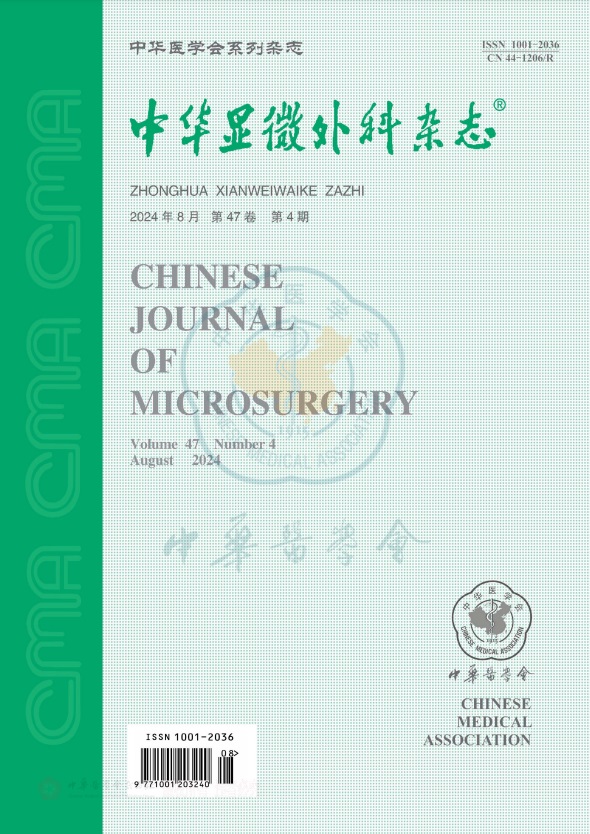The clinical application of the peroneal artery perforator flap in the reconstruction of tissue defect in maxillary malignant tumor resection
引用次数: 0
Abstract
Objective To evaluate the clinical effect of application of free peroneal artery perforator flap in repairing postoperative tissue defect after resection of oral maxillary malignant tumor. Methods From January, 2016 to June, 2018, 14 patients with maxillary malignant tumor were treated with tumor excision. Then the free peroneal artery perforator flap was used to reconstruct tissue defect caused by tumorectomy. There were 6 cases of squamous-cell carcinoma of palatine, 2 cases of adenoid cystic carcinoma of palatine, and 6 cases of maxillagingiva squamous cell carcinoma. The incised area of flap was 4.0 cm×5.0 cm to 7.0 cm×8.0 cm. There were 5 cases of hard palate soft tissue defect repair and 9 cases of simultaneous repair of soft and hard palate. Followed-up by outpatient service in 3-12 months after operation, postoperative maxillamorphology, phonetic function, swallow function, opening degree and prognosis of the patients were evaluated. Results All 14 implanted flaps were alive. One flap had vascular crisis, and rescued by surgical exploration and timely rescue. Three flaps were prolonged healing. All donor sites were sutured directly. All surgical incisions healed primarily. Half a year after the operation, the appearance of maxilla was formed gradually. The phonetic function, swallowing function, opening degree and movement of lower leg were all recovered normal. One year after the operation, epithelization was done in 6 cases. And there was no tumor recurrence. Conclusion The peroneal artery perforator flap has long vascular pedicle, larg diameter, high survival rate after vascular anastomosis and relatively concealed donor area. It can be used to repair and reconstruct the tissue defect in maxillary malignant tumor resection and achieved good result. Key words: Peroneal artery perforator flap; Maxillary malignant tumor; Soft tissue defect; Reconstruction腓动脉穿支皮瓣在上颌恶性肿瘤切除组织缺损重建中的临床应用
目的探讨游离腓动脉穿支皮瓣修复口腔上颌恶性肿瘤切除术后组织缺损的临床效果。方法2016年1月~ 2018年6月对14例上颌恶性肿瘤患者行肿瘤切除术。应用游离腓动脉穿支皮瓣修复肿瘤切除后的组织缺损。腭鳞癌6例,腭腺样囊性癌2例,上颌鳞癌6例。皮瓣切开面积4.0 cm×5.0 cm ~ 7.0 cm×8.0 cm。硬腭软组织缺损修复5例,软硬腭同时修复9例。术后3 ~ 12个月门诊随访,评估患者术后颌部形态、语音功能、吞咽功能、开口程度及预后。结果14个皮瓣全部存活。1个皮瓣发生血管危象,经手术探查和及时抢救抢救。3个皮瓣延长愈合时间。所有供体部位均直接缝合。所有手术切口基本愈合。术后半年,上颌外形逐渐形成。语音功能、吞咽功能、下肢开口度及运动均恢复正常。术后1年,6例行上皮化。无肿瘤复发。结论腓动脉穿支皮瓣血管蒂长,直径大,吻合后成活率高,供区相对隐蔽。应用于上颌恶性肿瘤切除术中组织缺损的修复和重建,取得了良好的效果。关键词:腓动脉穿支皮瓣;上颌恶性肿瘤;软组织缺损;重建
本文章由计算机程序翻译,如有差异,请以英文原文为准。
求助全文
约1分钟内获得全文
求助全文
来源期刊
CiteScore
0.50
自引率
0.00%
发文量
6448
期刊介绍:
Chinese Journal of Microsurgery was established in 1978, the predecessor of which is Microsurgery. Chinese Journal of Microsurgery is now indexed by WPRIM, CNKI, Wanfang Data, CSCD, etc. The impact factor of the journal is 1.731 in 2017, ranking the third among all journal of comprehensive surgery.
The journal covers clinical and basic studies in field of microsurgery. Articles with clinical interest and implications will be given preference.

 求助内容:
求助内容: 应助结果提醒方式:
应助结果提醒方式:


